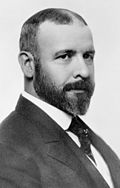Description and history
Merchants' National Bank was built in 1914 and had its grand opening on January the first, in 1915, along with the Purdue State Bank in Indiana, also designed by Sullivan. [5]
Structurally the building is a rectangular box, with a magnificent main facade and a windowed side facade.
Although this building is smaller than either his Owatonna or Cedar Rapids banks, it appears just as monumental. This is due largely to the oversized cartouche that surrounds a circular window on the Fourth Street facade. Light is introduced into the interior by a series of stained glass windows that alternate with structural posts down the side of the building and through the colored glass skylight that comprises much of the ceiling.
While the bank housed in the structure and its location, the small town of Grinnell, did not warrant wide national attention, yet the unveiling of the Louis Sullivan building was given national coverage in the architectural press of the day. The Merchants' Bank was featured in an eleven-page spread in The Western Architect's February 1916 edition. [6]
As he did in his banks in Cedar Rapids and Sidney, Ohio, Sullivan used lions, or at least a grotesque, winged version of a lion, as figurative decoration. This creature is one of the very few figurative elements that can be found in the architect's designs. (The angels in his Transportation Building and the Bayard-Condict Building being other examples.)
Some of the plans and even the designs of the ornament were done by Sullivan's draftsman Parker N. Berry, who was shortly thereafter to fall victim to the 1918 Spanish flu epidemic.
In the 1970s or early 1980s, a city beautification project sponsored the planting of several trees in front of the bank. Gebhard calls this an "unbelievable decision" for the growing plants would obscure more and more of the amazing facade. These plantings can be easily seen in the gallery pictures, taken in 1985. These trees were removed as of 2013.
In 2007, the city remodeled its downtown sidewalks and streets so the intersections of the square had the "Jewelbox" appearance to them. The city also put Planters at the four corners of the crossings which have the "Jewelbox" engraved in them.
Between 2008 and 2009, one of the lions in front of the building was damaged. Both lions have now been replaced.
This page is based on this
Wikipedia article Text is available under the
CC BY-SA 4.0 license; additional terms may apply.
Images, videos and audio are available under their respective licenses.











